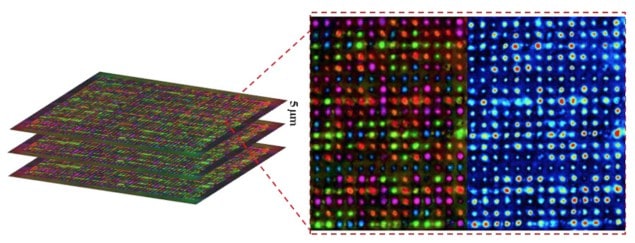
Data written to a glass “memory crystal” could remain intact for a million years, according to scientists from the UK and the Netherlands who have demonstrated the technology for the first time. The data-storage technique uses a laser to alter the optical properties of fused quartz at the nanoscale. The researchers say it has the potential to store a staggering 360 terabytes of data (equivalent to 75,000 DVDs) on a standard-sized disc.
Longevity and capacity are the key factors to consider in terms of data storage, but existing options are limited. “At the moment, companies have to back up their archives every five to ten years because hard-drive memory has a relatively short lifespan,” explains Jingyu Zhang of the University of Southampton, UK, who led the team that demonstrated the new technique. Optical storage media such as DVDs are more stable, but with standard single-layer discs maxing out at 4.7 GB of data, they are an unwieldy option for vast digital archives.
Scientists have been pursuing the idea of glass as a medium for mass data storage since 1996, when it was first suggested that data could be written optically into transparent materials. By using a femtosecond laser to alter the physical structure of fused quartz, a “dot” with a different refractive index can be created to denote the binary digit one; zeros are indicated by the absence of a dot. Japanese electronics giant Hitachi succeeded in storing data using this method back in 2009, but Zhang’s team has taken the technology a step further, by recording information in 5D – the three dimensions of space that describe the physical location of the dot, and two additional dimensions that are encoded by the polarity and intensity of the beam that creates the dot.
Superhero memories
To demonstrate the new method, Zhang’s team wrote a 300 kB digital text file into fused quartz glass using a femtosecond laser that produced extremely short and intense pulses of light at a 200 kHz repetition rate. The pulses were sent through a spatial light modulator (SLM), which split the light into 256 separate beams to create a holographic image. A specially designed laser-imprinted half-wave plate matrix was built to control the polarization of the light without the need for moving parts. The laser-imprinted dots were arranged in three planes separated by a distance of five microns, on a sliver of fused quartz, and dubbed “Superman memory crystals” after the once-fanciful technology featured in the Superman films.
The data file was read using a standard optical microscope in conjunction with a polarizing filter, to measure the way that light transmission was altered by the dots. The read-out showed each dot as a blurred spot of varying intensity, in one of four colours to indicate polarity – a level of optical data encoding that represents a significant improvement over simple 3D systems such as conventional DVDs or even Hitachi’s, according to Zhang. “Consider that when you read a DVD, while you read one spot it’s actually one bit, but in our case, it’s many more bits – 10 bits,” he explains, adding that they “expect 10 times higher reading rates too”.
Outlasting the human race
The researchers claim that their memory crystals “[open] the era of unlimited lifetime data storage.” As well as providing unprecedented capacity and high-speed reading, fused quartz is exceptionally stable and can withstand temperatures up to 1000 °C. “We think it should potentially last a million years,” enthuses Zhang, meaning the stored data will likely outlast the human race.
Xiangping Li, a physicist working on multidimensional optical data storage at Swinburne University of Technology in Hawthorn, Australia, calls the work “quite innovative”, and suggests that the estimated storage capacity would be beefed up even more if the parameters used for the fourth or fifth dimensions were less closely intertwined. “[Currently] these parameters are not orthogonal to each other, so it will create significant crosstalk…it’s a grey scale,” he explains.
Zhang’s group is designing a simple scanning laser read-out device that will enable the reading technology to be brought cheaply into homes in the near future. The same cannot be said for the writing technology, however – there needs to be a significant breakthrough before we could be saving our personal music and photograph collections to memory crystal. National labs, cloud-computing clusters and other large data-generating enterprises, on the other hand, are obvious immediate candidates for early adoption. “Museums that want to preserve information, or places like the National Archives where they have huge numbers of documents, would really benefit,” says Zhang.
The researchers are looking to combine with industry partners to develop a higher-powered laser but, ahead of that, they plan to switch the SLM for another on the market that should increase their writing speed from kilobytes-per-second to megabytes-per-second, and are keeping a keen eye on the current development of an even better version that should offer them speeds of gigabytes-per-second.
The research was presented at the 2013 Conference on Lasers and Electro-Optics, held in San Jose.



